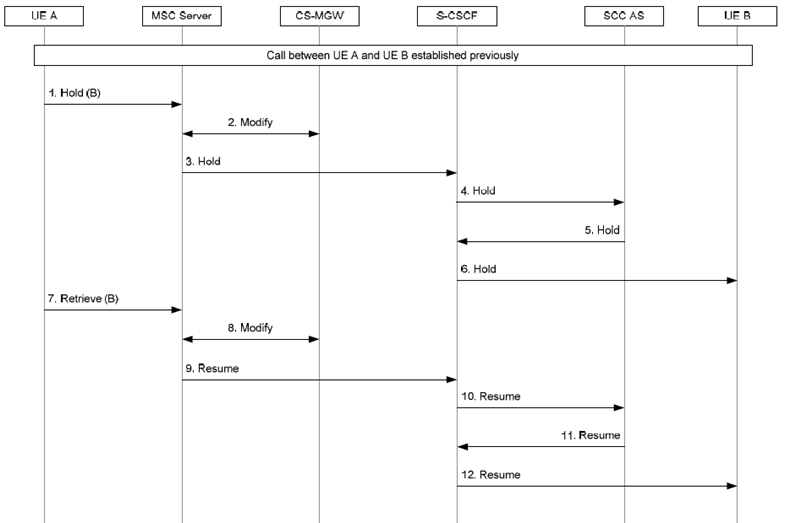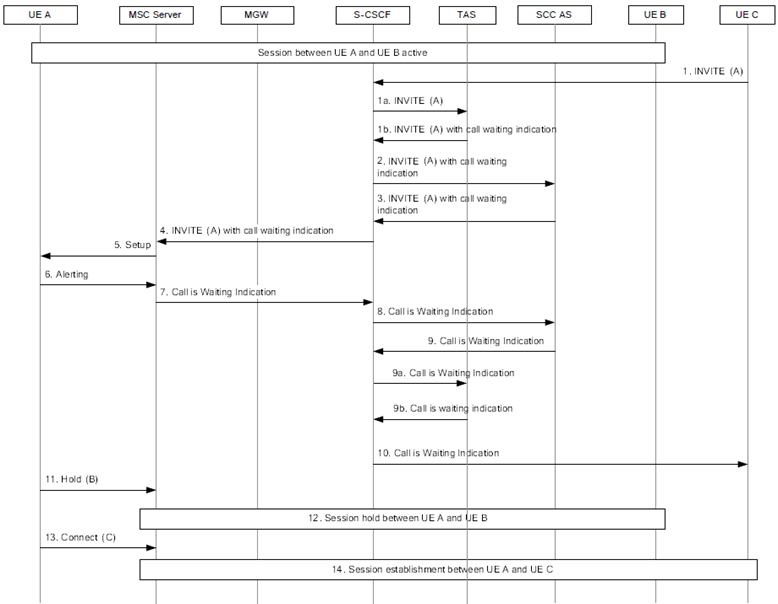Content for TS 23.292 Word version: 17.0.0
1…
4…
5…
7…
7.2…
7.3…
7.3.2.2…
7.3.2.2.4…
7.4…
7.4.2.2…
7.4.2.2.3…
7.4.2.2.7…
7.5…
7.6…
7.6.1.2.2.6…
7.6.1.2.3…
7.6.1.2.3.5…
7.6.1.2.3.6…
7.6.2…
7.6.2.7
7.6.2.8…
7.6.2.11…
7.6.3…
7.7…
7.7.2…
7.9…
7.9.2…
7.9.2.4
7.9.2.5
8…
A…
G…
H…
H.5…
H.5.3…
7.6.2 Supplementary service invocation using the MSC Server enhanced for ICS
7.6.2.1 Overview
7.6.2.2 Line ID Services (OIP, OIR, TIP, TIR)
7.6.2.3 Communication Diversion Services
7.6.2.3.1 Communication Forwarding Unconditional (CFU)
7.6.2.3.2 Communication Forwarding Busy (CFB)
7.6.2.3.3 Communication Forwarding No Reply (CFNR)
7.6.2.3.4 Communication Forwarding on Not Logged-in (CFNL)
7.6.2.3.5 Communication Deflection (CD)
7.6.2.3.6 Communication Forwarding on Subscriber Not Reachable (CFNRc)
7.6.2.3.7 Communication Diversion Notification (CDIVN)
7.6.2.3.8 Diversion notifications to originating users
7.6.2.4 Communication Barring
7.6.2.5 Communication Hold/Resume
7.6.2.6 Communication Waiting
...
...
7.6.2 Supplementary service invocation using the MSC Server enhanced for ICS p. 80
7.6.2.1 Overview p. 80
For IMS sessions established by non ICS UEs using the MSC Server enhanced for ICS, the I2 reference point is used for communication of service control signalling. The MSC Server enhanced for ICS shall perform the necessary interworking between the I2 reference point and CS signalling to allow the IMS to provide the IMS Multimedia Telephony Service as defined in TS 22.173.
7.6.2.2 Line ID Services (OIP, OIR, TIP, TIR) p. 80
For IMS sessions established by UEs using the I2 reference point, the MSC Server enhanced for ICS shall perform the necessary interworking between the I2 reference point and CS signalling (e.g. as described in TS 24.081) to allow OIP, OIR, TIP and TIR as described in TS 24.173 to be controlled by the IMS.
For OIP, the MSC Server may interwork any display name received in conjunction with the TEL URI or SIP URI to the CS signalling specified for the calling name presentation (CNAP) service (e.g. as described in TS 24.096).
7.6.2.3 Communication Diversion Services p. 81
For IMS sessions established by UEs using the I2 reference point, the MSC Server enhanced for ICS shall perform the necessary interworking between the I2 reference point and CS signalling (e.g. as described in TS 24.082) to allow Communication Diversion (CDIV) services to be executed in the IMS.
7.6.2.3.1 Communication Forwarding Unconditional (CFU) p. 81
Communication Forwarding Unconditional (CFU) is provided as specified in TS 24.173.
7.6.2.3.2 Communication Forwarding Busy (CFB) p. 81
Communication Forwarding network determined user Busy (CFB) is provided as specified in TS 24.173.
For Communication Forwarding user determined Busy (CFB), the MSC Server enhanced for ICS shall perform the necessary interworking between CS signalling (e.g. as described in TS 24.082) and the I2 reference point to allow the IMS to execute CFB.
7.6.2.3.3 Communication Forwarding No Reply (CFNR) p. 81
Communication Forwarding No Reply (CFNR) is provided as specified in TS 24.173.
The MSC Server enhanced for ICS shall allow the IMS to control the length of time allowed for the UE to reply to the communication request prior to invoking CFNR.
7.6.2.3.4 Communication Forwarding on Not Logged-in (CFNL) p. 81
Communication Forwarding on Not Logged-in (CFNL) is provided as specified in TS 24.173.
7.6.2.3.5 Communication Deflection (CD) p. 81
For Communication Deflection (CD), the MSC Server enhanced for ICS shall perform the necessary interworking between CS signalling (e.g. as described in TS 24.072) and the I2 reference point to allow the UE to deflect an incoming call back to the IMS for redirection to another user.
7.6.2.3.6 Communication Forwarding on Subscriber Not Reachable (CFNRc) p. 81
For Communication Forwarding on Subscriber Not Reachable (CFNRc), the MSC Server enhanced for ICS shall return the appropriate reply to the offered session to allow the IMS to execute CFNRc, (e.g. as specified in TS 24.604).
7.6.2.3.7 Communication Diversion Notification (CDIVN) p. 81
The support of interworking between CS signalling and the IMS for the CDIVN service is not supported at the MSC Server enhanced for ICS.
7.6.2.3.8 Diversion notifications to originating users p. 81
For IMS sessions originated by UEs using the I2 reference point, the MSC Server enhanced for ICS shall perform the necessary interworking between the I2 reference point and CS signalling (e.g. as described in TS 24.082 and TS 24.072) to allow the UE to receive notification that an origination was diverted, for use in networks which support this subscription option. This is applicable to all CDIV services.
7.6.2.4 Communication Barring p. 82
For IMS sessions established by UEs using the I2 reference point, the MSC Server enhanced for ICS shall perform the necessary interworking between the I2 reference point and CS signalling (e.g. as described in TS 24.088) to provide the UE with notification that a Communications Barring (CB) service was invoked.
7.6.2.5 Communication Hold/Resume p. 82
For IMS sessions established by UEs using CS media, the MSC Server enhanced for ICS shall perform the necessary interworking between the I2 reference point and CS signalling (e.g. as described in TS 24.083) to allow communication hold and resume to be controlled by the IMS.
Figure 7.6.2.5-1 describes how IMS communication hold and resume is performed via the MSC Server enhanced for ICS.

Figure 7.6.2.5-1: IMS Communication Hold and Resume via MSC Server enhanced for ICS
(⇒ copy of original 3GPP image)
(⇒ copy of original 3GPP image)
Step 1.
UE A sends a Hold message to the CS network (e.g. as specified in TS 24.083).
Step 2.
The MSC Server initiates interaction with the CS-MGW over the Mc reference point instructing it to stop sending the media stream toward UE B but to keep the resources for the session reserved.
Step 3.
The MSC Server sends the Hold message to the S-CSCF indicating the session is being put on hold as described in TS 24.173.
Step 4.
The S-CSCF sends the Hold message to the SCC AS as it was inserted at session establishment.
Step 5.
The SCC AS sends the Hold message to the S-CSCF.
Step 6.
The Hold message is forwarded to UE B.
Step 7.
UE A sends a Retrieve message on the CS network (e.g. as specified in TS 24.083).
Step 8.
The MSC Server initiates interaction with the CS-MGW over the Mc reference point instructing it to resume sending the media stream toward UE B.
Step 9.
The MSC Server sends a Resume message to the S-CSCF indicating the session is being resumed as described in TS 24.173.
Step 10.
The S-CSCF sends the Resume message to the SCC AS.
Step 11.
The SCC AS sends the Resume message to the S-CSCF.
Step 12.
The Resume message is forwarded to UE B.
7.6.2.6 Communication Waiting p. 83
For IMS sessions established by UEs using the I2 reference point, the MSC Server enhanced for ICS shall perform the necessary interworking between the I2 reference point and CS signalling (e.g. as described in TS 24.083) to allow Communication Waiting (CW) to be controlled by the IMS. A UE may reject a waiting call.
Figure 7.6.2.6-1 describes how IMS CW is performed via the MSC Server enhanced for ICS.

Figure 7.6.2.6-1: IMS Communication Waiting via MSC Server enhanced for ICS
(⇒ copy of original 3GPP image)
(⇒ copy of original 3GPP image)
Step 1.
An incoming INVITE is received at the S-CSCF of UE A.
Step 1a.
S-CSCF forwards the INVITE to TAS.
Step 1b.
The TAS detects the CW condition and inserts Call waiting indication into the INVITE request. The TAS sends the INVITE to S-CSCF.
Step 2.
Filter criteria direct the S-CSCF to send the INVITE to the SCC AS.
Step 3.
The SCC AS sends the INVITE to the S-CSCF.
Step 4.
The S-CSCF forwards the INVITE to the MSC Server based on the contact address stored during registration.
Step 5.
The MSC Server sends a Setup message to UE A to inform it of the waiting call (e.g. as specified in TS 24.083).
Step 6.
UE A sends an Alerting message for the waiting call.
Step 7.
The MSC Server sends an indication that the call is waiting.
Step 8.
The S-CSCF forwards the indication that the call is waiting to the SCC AS.
Step 9.
The SCC AS forwards the indication that the call is waiting to the S-CSCF.
Step 9a.
The S-CSCF forwards the indication that the call is waiting to the TAS.
Step 9b.
The TAS forwards the indication that the call is waiting to the S-CSCF.
Step 10.
The S-CSCF forwards the indication that the call is waiting to UE C.
Step 11.
The ICS User accepts the call and UE A sends a Hold message to put the existing session on hold.
Step 12.
The existing session between the MSC Server and UE B is put on hold as described in clause 7.6.2.5 of this specification.
Step 13.
UE A sends a Connect message for the waiting call.
Step 14.
Completion of the IMS session setup procedures.